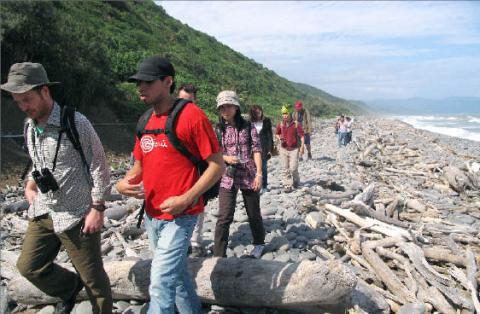|
Protect Alangyi
Trail, specialists urge
ETERNAL ASSET: The environmentalists emphasized
that attractions must not be over-developed, but kept in their natural state to
lure tourists for years to come
By Lee I-chia / Staff Reporter

Members of the Society of
Wilderness and foreign non-governmental organization representatives walk along
the historic Alangyi Trail on Taiwan¡¦s east coast yesterday. The trail, which
runs between Taitung and Pingtung counties, is under threat from a planned
highway construction project.
Photo: Tsai Tsung-hsien, Taipei Times
Four environmental specialists who
participated in the 10th Asia-Pacific NGO Environmental Conference in Taipei
visited the historical Alangyi Trail (ªü®Ô³ü¥j¹D) yesterday and met Pingtung County
Commissioner Tsao Chi-hung (±ä±ÒÂE) to share ideas on protecting the trail.
The tour followed on the international NGO conference hosted by the Society of
Wilderness which ended on Monday.
The Alangyi Trail, a 12km hiking trail along the Pacific coastline between
Taitung County¡¦s Nantian Village («n¥Ð) and Pingtung County¡¦s Syuhai Village (¦°®ü),
is being threatened by the planned construction of Provincial Highway No. 26. A
section of the planned highway would run alongside the trail.
The group of specialists started walking at Nantian and headed south on the
pristine trail, passing through the mouth of a stream and walking along the
shore covered with round rocks and driftwood, while environmental tour guides
from local NGOs explained the ecological features.
Holding a live tree crab in his hands, a tour guide said more than 1,000 crabs
per night would cross the trail during breeding season.
After a walk of about 2km along the trail, the group met Tsao at the Pingtung
County Hall to share their experiences.
Chairperson of the Asia-Pacific Environmental Council and professor at Tokyo
Keizai University, Yayoi Isono, said she loved walking along the ancient trial.
She added that it was a beautiful place with many natural resources and hoped
the government would protect the area.
A reserve manager at the World Wide Fund for Nature in Hong Kong, Bena Smith,
said rather than always opposing construction, NGOs should provide alternatives
and reach compromises with developers or the government.
Pierre Fidenci, founder and president of Endangered Species International, said
the matter reminded him of a case in southern France, where activists spent a
few years stopping the construction of a highway.
He said tourism was very important in France and that the people and government
had gradually learned that ¡§tourism is not only about convenient transportation,
but also preserving the beautiful landscape the way it is¡¨ and ¡§making it unique
can also increase the number of tourists over the years.¡¨
Stuart Rosewarne, of the department of political economy at the University of
Sydney, emphasized that the importance of developing eco-tourism is not to
over-develop areas, but to educate tourists to be environmentally aware.
Tsao said the nature reserve¡¦s resources and landscape are precious assets, but
the government faces heavy pressure from local residents to build the highway.
This is because they were taught that transportation is the most important
aspect of tourism and improving their lives, and do not fully understand the
benefits of keeping the area pristine.
¡§When we want to protect a natural attraction [in Japan], it is also hard to
have dialogue with the local people, because some of them want economic
development or convenient transportation,¡¨ Isono said.
¡§If that is the case, how to promote dialogue between the government, NGOs and
local people should be considered when making plans [for development].¡¨
|
![]()
![]()
![]()